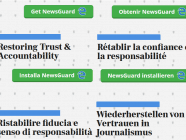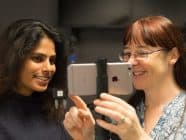All over the world, the media are striving to diminish the distance which separates them from their audiences: by increasing interactivity, explaining journalistic practices to their audiences, or even involving citizens in the search for newsworthy events. Public-service broadcaster Swedish Television goes one step further by launching a project that is aimed at giving its viewers direct access to the decision making processes involved in the production of one of its television news programmes. An innovative approach which nevertheless raises a few questions. Six months after the launch, project leader Eva Landahl takes stock.
The project has also had some positive effects on the journalists themselves. “Working in front of a camera has improved not only the language used during our conversations but also the quality of our arguments”, Eva Landahl explains. However, there have been some complications, especially during the sessions that serve to evaluate the news program aired the day before. Imagine you are a professional journalist who is criticised for his work by his boss. Then imagine that the whole scene is filmed and made available on the Internet shortly afterwards, accessible to everyone with a computer. Without a doubt, a situation that is difficult to deal with. Moreover, working under the watchful eye of a camera can become exhausting. So, after a running time of six months: has it all been worthwhile? According to project leader Landahl, the positive effects certainly outweigh the negative ones. “I’ve been in journalism for 20 years, and me and my colleagues have often been criticised by people who questioned our choices, for example after we had disclosed a name or published a certain picture. My impression has always been that people think we, the journalists, are making these choices arbitrarily.” The merit of Öppen Redaktion lies in the fact that it helps Swedish citizens understand that such difficult choices are not taken lightly. Quite the contrary: some of the internal debates available on the Internet – ranging from polite to heated indeed – offer valuable insights into the journalistic decision making process, in a format that is accessible to a general audience as well. In fact, between 1,500 and 2,000 people visit the Aktuellt website daily. “My hope is”, concludes Eva Landahl, “that our viewers, by getting all this insider information, arrive at a deeper understanding of the news program we offer them every day. Last but not least, I also hope that our efforts at making our internal operations more transparent will ultimately strengthen people’s trust in what we’re doing.” Whatever the real objective of this project – achieving genuine transparency or regaining lost credibility by means of a clever PR stunt – Öppen Redaktion definitely offers an added value to Swedish TV viewers. For as a result of this project, now they can not only watch their favourite news program – but also understand it at a much deeper level.
Interview with Edy Salmina, head of information at Swiss Italian TV and radio broadcaster RTSI
Could a project like Öppen Redaktion also be realised in our country?
To me, filming staff meetings and uploading the images on the Internet seems more like a clever trick – rather than a genuinely good idea, more a reality show than a slice of real life itself. Take, for example, a painter: if you film him during his work, does this really improve our understanding of his work? I think that true transparency can only be achieved by making public the guidelines of our journalistic work – not by filming editorial staff meetings. While the results of that journalistic work definitely belong to the public sphere, the same is not necessarily true for the efforts that go into producing those results. Moreover, given the small size of our sector, I see some additional dangers lurking here. For example, what about journalists’ right to privacy? And what about their freedom of speech?
Let’s assume there won’t be a Swiss Italian variant of Öppen Redaktion for the moment. Still, transparency towards the audience is a vital goal for RTSI as well. What do you do to guarantee it?
The whole news production process is made transparent in several ways. By publishing our internal editorial guidelines; by taking a stand on public issues; by being accountable to our audiences, which we invite to assess the quality of our programs, over the Internet, for example; by inviting the public to our studios; by informing people about important internal appointments; by publishing viewer and listener figures for our TV and radio programs; by hiring interns; by collaborating with public institutions such as the Università della Svizzera Italiana; and, finally, by entering into a dialogue with the public. Let’s not forget that the RTSI is supervised by a public institution with a cooperative structure, the CORSI (Società cooperativa della Radiotelevisione Svizzera di lingua italiana). Of course, there are still other ways of increasing transparency, a specialised program blog, for example. However, I think our most important concern should always be the quality of our programs and the journalistic creativity that goes into making them, especially in our multimedia times.
• the public gains a better understanding of the inner workings of a newsroom;
• newsroom members are prompted to think more carefully and find better arguments;
• credibility is enhanced: people come to realise that journalists have nothing to hide;
• “conspiracy theories” turn out to be untenable;
• journalists get a feedback on their internal work routines;
• the distance between journalists and the public diminishes;
• journalists can live up to their own standards by showing the same transparency they often demand from public figures or institutions;
• a groundwork is laid for a more meaningful dialogue between journalists and the public;
• the people in charge of journalists’ training and education get access to valuable material that serves to illustrate the internal decision making processes typical for this line of work.
NO because
• journalists’ competitors gain access to valuable information;
• PR experts (“spin doctors”) can react faster and more efficiently to any uncomfortable disclosures made by reporters;
• internal editorial debates may become less spontaneous and honest;
• a false sense of “transparency” is created;
• the real decision making takes place somewhere else;
• people may find it easier to sue a certain journalist or medium;
• serious attempts at increasing transparency could degenerate into mere publicity stunts;
• newsrooms come across as highly egocentric structures;
• the images broadcast over the Internet may turn out to be repetitive and boring.
Tags: Öppen Redaktion, PR, Sweden, Television, transparency












































